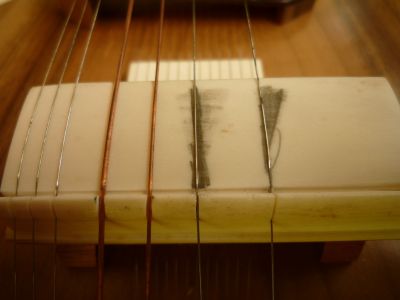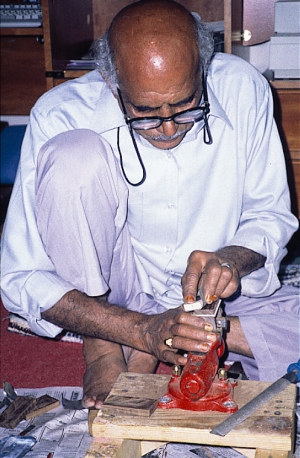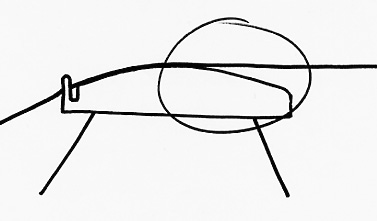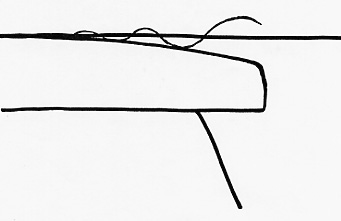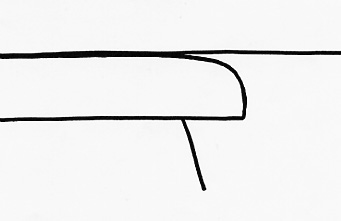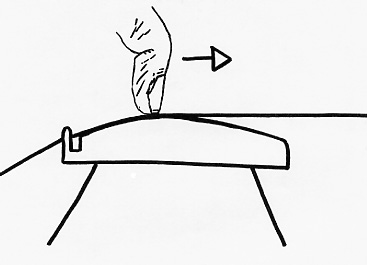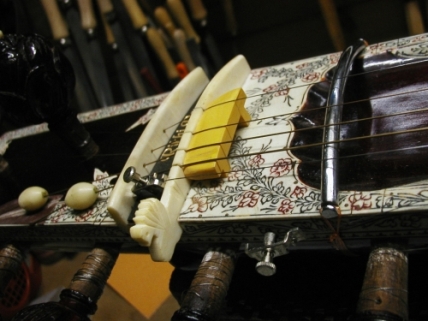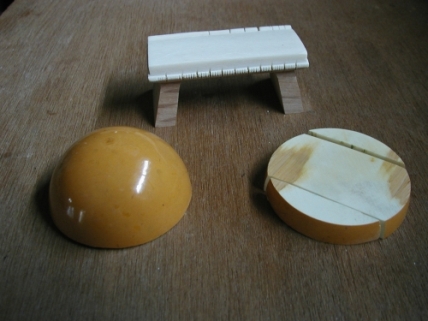Common knowledge
The most radical maintenance work on a sitar is undoubtedly, and most commonly named, “(doing) jawari”. The correct meaning of the word “jawari” (or “jiwari”) is “saddle which gives life to the sound”. It comes from the hindi combination of “jiv” (= life) & “sawari” (= saddle). The actual bridge, as we casually also adress to as “jawari” is in fact called ghoraj or ghodi. This is a construction of wooden legs, glued to a piece of hard material in a rectangular shape and a curved surface. How to make a ghoraj can be seen here.
The legs are made of tun, teak or even sheeshum but also mahogany, ahorn, rosewood or almost any other fine quality wooden leftover piece can be used. The harder the wood, the clearer and louder the sound that will come out. The upper part of the ghoraj, the ghodi, is also made of a hard material. Professional quality sitars are usually fitted with a piece of staghorn. The antlers of the barasingha, a type of deer native to India & Nepal, are most wanted for this but they became very rare and are now protected. Nowadays many sitar makers experiment with synthetic materials. The sound which comes from a fine piece of fiber is a bit different, but at least very useful and comparable to staghorn. And they have a big advantage that they resist wear much more better than any other material such as camel bone, ebony, rosewood, ivory, buffalo horn and staghorn.
Jawari’s basic principles

Very important is the curved shape of the bridge and in particular the narrowing between bridge and string. This is the most important factor, determinating the typical sound of a sitar. Since the bridge is wide (2,5 – 3 cm) the contact with the string is spread over a longer distance. This makes that a vibrating string will have several “touching points” which generate extra harmonics. These create a very rich, complex resonating, almost self entertaining, and evolving buzzing sound.
Two main extremes are to be distinguished
1. Open jawari or “khula” (= open sound, for ex. Ravi Shankar style) is created by a long and wide narrowing between strings and bridge. This combination is full of harmonics and sounds very bright, loud and buzzy.

2. Closed jawari or “band” (= closed sound, for ex. Vilayat Khan & Balaram Pathak style) is created by a rather short and small narrowing between strings and bridge, or even no narrowing at all. This sounds more warm and less, or even not buzzy at all. A great advantage is the high gain in sustain.

These two main types are scarcely found under their extreme form. (Only a tanpura has an extremely open bridge). In reality the sound of the bridge is mostly in between these two types, guided by personal preference and gharana style.
The degree of widening can easily be detected. Put your fingernail on the string and then gently slide with your fingernail perpendicular to the string over the bridge while the string is vibrating. At the point where the bridge becomes open suddenly intense vibrations will be observed.

Workflow
Use long and flat, coarse to second cut files. Depending on the amount of material which should be removed to obtain a desired curve. Or, in case of regular maintenance jawari work the choice of your file may be determined by the amount of wear. Make sure your files are always clean and intact. Fine cut files and sandpaper are used for the finishing touch. A fine clue which Hariji taught me is to use the backside of sandpaper to give a final polishing stroke.
For a good result it is important that you can keep the ghodi surface solid and stable against the file. A very helpfull tool might be a good workbench vice to firmly clamp the ghodi. Or even better, use a traditional Indian floor bench vice. Take a look here if you want to make one yourself.
Doing jawari is a question of practice. No written rules exists on how, where and when to start filing or sanding. Just take your time to create a slow but steady, exponentially inclined curve. At regular times, create a finishing stroke with fine sandpaper and try out on your instrument. Remove it again and work further, step by step. It’s also a good idea not to experiment with your one and only fine staghorn jawari but look out for a piece of cheap camel bone, leftover ebony or fiber and make your own ghoraj from scratch. It might take some time, but once you succeed to create a good sound with a self-made jawari…
Finetuning
When your sound starts to come, you can feel the desire that one or more strings should sound different. For example, you want cikari strings to sound more open than playing strings, or laraj kharaj only to become more closed. From that moment onwards you should work locally by means of a scraper. This is a cutting tool which is used in a perpendicular position towards the surface. Make sure your cutter is not too wide but very sharp and clean. Relax the string and pull it aside. Remove some material by scraping it off. Make the narrowing wider if you want a more open sound, or remove some material from next to the point where the narrowing begins to make the string go deeper and as such making the narrowing smaller to obtain a more closed sound.
Before you start
Note that a jawari is never glued to the tabli. It should always be possible to remove it without force. In case of problem, one can mount one or two very small bone pins to prevent the jawari from sliding away while playing meend. Sometimes a drop of shellack is applied to the feet in order to fix the jawari. But, before you remove a jawari, make sure to be able to put it again in the same position. If needed, mark the feet’s position by making a small incision on the tabli with a sharp knife or chisel.
If you want to change the sound more drastically from open to closed sound or reverse, it is better to work on the jawari’s full inclination first. This is done by removing a very small amount of wood from under the jawari’s feet. Removing wood from the frontside onwards, will make the jawari turn over to a wider narrowing with the strings and thus make it sound more open. Removing wood at the backside will make it turn over to a smaller narrowing and make the sound more closed. For this you can use a coarse or second cut file, or cut the wood away with a sharp chisel. Make sure that the feet’s original curve is maintained so that the jawari is in perfect contact surface with the tabli.
A note about dimensions
The dimensions of a sitar’s ghodi can range from 6.5cm x 2.6cm to 7.5cm x 3cm. Smaller bridges are often installed on the older sitars and on Vilayat Khan style sitars (only 6 strings – more closed sound). Ravi Shankar, Nikhil Banerjee etc are more likely to use slightly wider and larger ghodis because they offer more tonal possibilities (open – half-open sound) and because there are one or two more strings on the ghodi.
There is no such thing as the perfect height of a ghodi. It can vary from 2cm (especially old sitars) up to 3.4cm. The final height of the ghodi on your sitar is mainly determined by the action of the strings. This is the distance between the playing string and the fret at the position of the highest note (this is the fret closest to the ghodi – or sometimes the 17th fret, high SA). This distance is best between 8 to 11mm. The height of the ghodi is thus adjusted until you reach an action of approx. 8 to 11mm.
Ready for more ?
How to make a ghodi
Dead notes
Jora tar tuning problem
The Indian floor bench vice
Black buffalo horn

